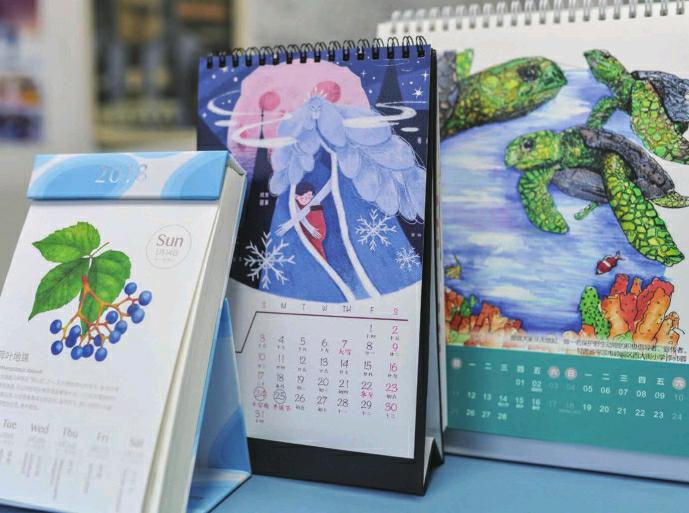Days Gone By
2018-01-22ByWeiYao
By+Wei+Yao


Zhao Mingye and her colleagues had to labor through the weekend on December 9, 2017. The website Guokr.com, where they work, held a unique fair at a shopping mall in downtown Beijing, which attracted tens of thousands of cultural creation lovers trying to find something they might be interested in. The number of customers far exceeded their expectations.
A species a day
The City Species Calendar is the fi rst calendar product undertaken by Guokr.com. The websites primary business is the popularization of science knowledge, and the idea for a science themed calendar emerged during discussions about cooperation methods with their partners in 2014. The result is a calendar that introduces a different species every day complete with a pretty illustration of the relevant animal or plant.
“This calendar is scientific and our website is good at this sort of content. We interact well with our followers. We know what our readers are interested in and what kind of content is meaningful to them,” Zhao said.
“We had never sold such products before,” she said while recalling the sales of the fi rst City Species Calendar at the end of 2014.
“In our Taobao shop, we sell some sideline products from the website. We originally had only 2,000 printed copies, which were at fi rst thought to be too many. But they were sold out within two hours and we were out of stock. We rushed to print another 20,000 copies which were then all gone within another two days,” Zhao said.
In December 2017, more than 200,000 copies of the 2018 City Species Calendar were sold, and its believed that the upcoming sales will surpass this number.
In response to the reaction from customers and readers of the website, the team has also produced an English-language version of the 2018 Species Calendar, which before long was sold out on Taobao, Chinas largest online shopping platform.
“A lot of people have told me that they want to give these calendars as gifts to foreign friends,” said Zhao, who believes that as long as the content is attractive, there should be no boundaries for cultural products.
Zhao attributes the popularity of the City Species Calendar to its uniqueness. This calendar is quite different from the kind of calendars that have been widely used in the past three decades, such as wall calendars and table calendars. Particularly innovative is the social network WeChat account for the calendar, which provides subscribers with a daily introduction to the species of the day.endprint
“In this way, we mean to bring consumers closer to knowledge,” said Zhao.
As a result, the sales of the City Species Calendar keep growing with each passing year, while subscribers to the WeChat account are also increasing apace, now standing at 800,000.
Calendric revival
The rocketing popularity of the City Species Calendar is in some ways connected to the rise of public interest in the natural sciences, but it is not the only calendar whose stock is on the rise. Signs from elsewhere seem to suggest that there is something of a revival taking place for Chinas calendar products.
The Palace Museum Calendar is another fashionable item amongst enthusiasts. At the end of 2009, the Palace Museum produced its 2010 calendar, a replica of the calendars issued from the years 1932 to 1936. The front page features the dates of both the lunar and Gregorian calendars, with solar terms stressed in a certain calligraphic script. On the reverse side are printed national treasures from within the Palace Museum, such as bronze wares, porcelain, jade artifacts, calligraphy and paintings. The classic style of this calendar was well received by consumers, and by the end of November 2017, 500,000 copies of the 2018 Palace Museum Calendar had been sold.
The laohuangli is a traditional Chinese calendar that contains information on the days alleged fortune and taboos as well as the date, much the same as horoscopes in Western astrology. But in the early 1980s, wall calendars began to replace laohuangli, and as smartphones become popular, wall calendars have themselves been marginalized by the digital calendars ubiquitous to smartphones.
However, recent years have seen the revival of traditional calendars. What seems to be attracting consumers are the cultural factors incorporated in the design of these calendars, with the generation of people born in the 1980s and 1990s the major consumers. Douban, a popular social network platform for TV, fi lm, music and book lovers, has created their own version called the Movie Life Calendar. According to the team, paper calendars indicate the return of some aspects of traditional culture and peoples pursuit of formalized and ceremonial experiences which are scarce in the modern world. The growing popularity of paper calendars reveals the nostalgia which underlines this modern age of rapid development. endprint
endprint
